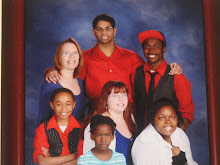I have read some shocking stuff about "therepeutic restraints" of late. I confess I hadn't been thinking about that much. I am lucky that Fiona's placements have not in the past 10 years been places that typically have any sort of physical restraint. If anything is truly uncontrolled the police are actually called and the youth is transported to the hospital. As is often the case, they typically stablize in the ER and then go back to school. The school is okay with that too. They don't want placement in the hospital if there is not a need, but this is just how they handle it when things get scary. So I am not too concerned for physical things happening when she is out of control.
But it made me think of how we were instructed to do holds on Chet at home when he was young. From about age 3 to about age 7, we were told that when he was wildly physically out of control (which happened a fair bit) we were to hold him. Intellectually it made sense to a first time parent with a child who acted in ways that I did not understand at all. Holding him would stop the sensory overload, would give him a moment to breathe and to listen and process.
Except the reality was just the opposite. The holding made him feel less in control and as time went by he would fight them harder. We explained that. We were told to "graduate" from something called a basket hold to something similar but also pinning his feet. I can't now remember exactly how we were supposed to do it. But when we did that, he learned to bang with his head while he growled and fought.
It just.did.not.work. It was a horrible place to be in. As a parent, many of us feel that at some level our kids need to know that we are "in charge." That is obviously a loose term that is interpreted in many different ways in many different families. Stopping the holds, even though they were not working felt like we were saying at some level that we were not in charge. But it was clear that if we continued someone (and truthfully it was likely to have been my wife) would have been hurt. This was clear. My son has always been strong, particularly when he was raging.
We consulted another professional. They recommended putting nails in a board in our yard so he could go hit them when he was angry. Except that when he raged he would not stay outside. When my wife tried to make him stay outside, his perception, so skewed by rage and autism was that she was throwing him out of the house. So much for plan B. That was probably around the time that I sort of gave up on professionals too. LOL
We were also lucky at the time that we lived just the 3 of us in a very large house. So we could escort him to his own space and leave him there until the storms passed. And despite my wife and others thinking that we were "giving in" that is what we did. My wife agreed to step back from the situations when he became angry and to let me take the point position. He has never been as likely to be physically agressive with me and this was safer all around.
But reading the articles on line, I think of the "what ifs." What if, in our quest to prove to Chet that we were his parents and were supposed to be listened to and all that, that we had continued. Would we all be here today, unharmed? Would we be the healthy unit that we by and large are today? I wonder. If life gave "do overs," I'd want one for this. It is a parenting regret that I ever for a minute believed that this was helping my son.
Looking back at the hold stuff, I can see the inhumanity of it. It isn't soothing. It is controlling. People receive and accept comfort in different ways. Chet needs to burrow under heavy blankets and stop the flooding with quiet. Fiona needs quiet space. Rob needs music. KC wants cuddling. Lissa wants to be near you but not talk about what she is angry about until later. It can be hard, particularly in a large family to remember everyone's specific needs in a charged situation, but that is my job as a parent.
Subscribe to:
Post Comments (Atom)





1 comment:
Thank you Lee, for this post about the use of “therapeutic restraint”, which is a subject very close to my heart.
I am relieved that they do not employ that kind of restraint at Fionia’s placement. Yes, holding therapy and blanket restraints are also advised to the parents of autistic and children with other special needs as well, it is not just limited to traumatized children and or children with RAD.
Restraint is so counter to common sense, let alone dangerous that I am amazed that professional therapists still recommend it, not as a safety measure but as a therapy. Our most basic instinct is the fight or flight response. If you tackle some one and hold the down the WILL FIGHT! And they will be pissed. They may calm down eventually, but you have just further traumatized them and are creating a vicious cycle of more rage. Let alone they next time they start to get off track they will have more anxiety in anticipation of the possibility of being restrained.
I don’t blame you or the staff who did that to me, you and they were doing what they were told by professionals who they (and You) assumed knew better than ththem. But with so many tragedies like the deaths of Candace Newmaker and Angellika Arndt they should know better by now.
Post a Comment